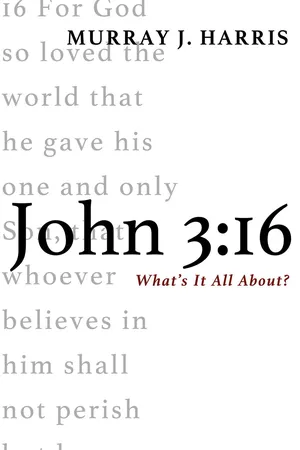
This is a test
- 54 pages
- English
- ePUB (mobile friendly)
- Available on iOS & Android
eBook - ePub
Book details
Book preview
Table of contents
Citations
About This Book
What is the most famous and influential sentence of all time? Was it spoken or written in Mandarin or German or English--or Greek? And who spoke or recorded this sentence? A case could be made that twenty-five words found in the third chapter of the Gospel of John in the New Testament of the Bible are history's most celebrated and powerful sentence. Writing for laypersons and specialists alike, in this little book Murray J. Harris, a specialist in Greek grammar, analyzes John 3:16 with the sort of care and precision that has marked his fruitful career in New Testament scholarship.
Frequently asked questions
At the moment all of our mobile-responsive ePub books are available to download via the app. Most of our PDFs are also available to download and we're working on making the final remaining ones downloadable now. Learn more here.
Both plans give you full access to the library and all of Perlego’s features. The only differences are the price and subscription period: With the annual plan you’ll save around 30% compared to 12 months on the monthly plan.
We are an online textbook subscription service, where you can get access to an entire online library for less than the price of a single book per month. With over 1 million books across 1000+ topics, we’ve got you covered! Learn more here.
Look out for the read-aloud symbol on your next book to see if you can listen to it. The read-aloud tool reads text aloud for you, highlighting the text as it is being read. You can pause it, speed it up and slow it down. Learn more here.
Yes, you can access John 3:16 by Harris in PDF and/or ePUB format, as well as other popular books in Théologie et religion & Religion. We have over one million books available in our catalogue for you to explore.
Information
Subtopic
ReligionNotes
7. Our English word “gospel” comes from the Old English word, gōdspel (gōd, “good,” and spel, “news”) referring to the “glad tidings” preached by Christ and, more generally, the whole revelation brought by Christ. Then the term was applied to the record of Christ’s life and teaching found in Matthew, Mark, Luke, and John; thus, “The gospel according to Matthew/Mark/Luke/John.” Finally these four records themselves were called the Gospels. There is only one gospel, but there are four Gospels.
8. Until the early nineteenth century, church tradition almost unanimously maintained that the author of the Fourth Gospel was the apostle John, the son of Zebedee (Mark 1:19–20; 10:35) and brother of James (Acts 12:2). But many modern scholars argue that the internal evidence provided by the Gospel itself points to another person (such as John the Elder [2 John 1] or the “Beloved Disciple” [John 13:23]) or group (such as the leaders of a “Johannine community”) as the author(s). For a discussion of all the relevant issues, see Craig S. Keener, The Gospel of John. A Commentary (Peabody, MA: Hendrickson, 2003) 1:81–115. I shall be assuming that the author is the Apostle John and that he is to be identified with “the disciple whom Jesus loved” (the Beloved Disciple).
9. Although three important proto-Alexandrian MSS (p66vid א* B) read i[na pisteu,hte (hina pisteuēte, present subjunctive), representatives of the later Alexandrian text-type (C L W 33 1241) along with Western (D) and Byzantine (A N Δ 700 1010 1424 Byz Lect) witnesses read i[na pisteu,,shte (hina pisteusēte, aorist subjunctive). The UBS4 Committee “had difficulty in deciding which variant to place in the text” (B. M. Metzger, A Textual Commentary on the Greek New Testament, 2nd ed. [Stuttgart: German Bible Society, 1994] 14*, 219–20). It is often claimed that the difference between the two tenses may be expressed by “that you may continue to believe” (present, NRSV footnote; cf. NEB text, “that you may hold the faith”) and “that you may come to believe” (aorist, NRSV; NEB footnote). That could be the difference between the two readings, but we should not overlook two facts: (1) John uses the present tense of pisteu,w (pisteuō) to denote both coming to faith and continuing in faith (e.g., John 6:29). (2) The aorist tense simply states a bald fact (“that you may believe”) without in itself specifying the nature of the action involved, whether it be progressive, iterative, or punctiliar. The preferred reading is i[na pisteu,shte and may point to either ongoing or single action, that is, it may refer to continuing to believe or coming to faith. (The idea of repeated action is inappropriate with the verb pisteu,w). This means that neither a pastoral nor an evangelistic aim should be excluded on the basis of 20:31 alone; the intended audience may well be both Christians and non-Christians.
10. Each of the four Evangelists probably had the four aims mentioned (P–...
Table of contents
- Title Page
- Acknowledgments
- Abbreviations
- Introduction
- The Context of John 3:16
- An Examination of John 3:16
- Final Comments
- Notes